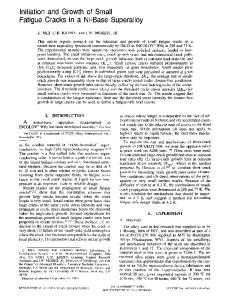role of crack tip shielding in the initiation and growth of long and small fatigue cracks in composite microstructures
- PDF / 3,362,937 Bytes
- 15 Pages / 594 x 774 pts Page_size
- 108 Downloads / 344 Views
I.
INTRODUCTION
C R A C K extension is generally considered to be driven by the presence of a "crack driving force" and opposed by the resistance of the microstructure, where the driving force is globally defined by a characterizing parameter, such as the stress intensity K~, describing the dominant crack tip stress and deformation fields. It is thus the perception that toughening, or restriction of crack growth, is achieved by increasing the inherent microstructural resistance, e.g., by coarsening particle spacings, etc'. (intrinsic "toughening"*). *"Toughening" Is used here in a general sense to imply mechanisms which tmpede crack extension, and thus is apphed to both subcrlUcal and critical behavior
However, in many cases, the actual source of toughness arises from a process of crack tip shielding, where crack extension is impeded by mechanical, microstructural, and environmental factors which locally reduce the crack driving force (extrinsic "toughening"). 1'2 Notable examples under monotonic loading are transformation toughening in ceramics 3'4 and ligament toughening in composites 5 (Figure l). Crack tip shielding processes are also of importance under cyclic loading, but relate primarily to crack deflection 6 and crack closure from wedging, bridging, and sliding phenomena between crack surfaces. 7-~5 Specific closure mechanisms can involve the wedging action of corrosion debris, ~'~'~~fracture surface asperities, 11,12,1~and fluid pressure, 14 and the presence of cyclic plasticity in the crack wake.~5 With the exception of the latter, all are enhanced
JIAN KU SHANG, Graduate Student. and R. O. RITCHIE, Professor. are with Matenals and Chemical Sciences Division. Lawrence Berkeley Laboratory, and Department of Matenals Science and Mineral Engineering, University of California, Berkeley, CA 94720. J. -L. TZOU, formerly with the Department of Matenals Science and Mmeral Engineering, University of California, Berkeley, CA 94720, is with National Semiconductor Corporation, Santa Clara, CA 95051. Manuscript subnutted October 16, 1986 METALLURGICAL TRANSACTIONS A
at low stress intensities due to smaller crack tip opening displacements (CTOD) and the greater tendency of cracks to follow a microstructurally-sensitive or crystallographic crack path. For fatigue crack advance under small-scale yielding, the effect of shielding is locally to reduce the nominal range of stress intensity, AK, given by Kn~, - K ..... to some effective value, AKc~f, actually experienced at the tip, although computation of AKef~ depends critically on the dominant mechanism of shielding. For example, crack deflection produces a multiplicative reduction in Mode 1 stress intensities, i.e., A K is reduced by a decrease in K .... and a smaller decrease in K ...... which may be expected to have an equal effect throughout the range of growth rates (unless the crack path morphology changes). Bridging or sliding mechanisms, conversely, lower AK by a decrease in K .... and an increase in Kmm. Most closure mechanisms, however, involve principally
Data Loading...











